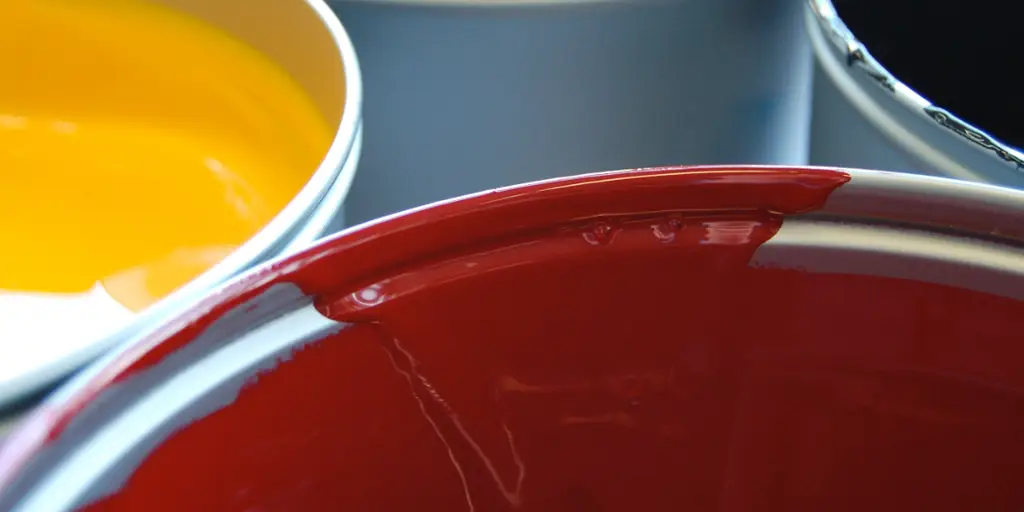Achieving the right paint consistency is paramount for both professional painters and DIY enthusiasts. A smooth, flawless finish is often the result of using the perfect blend of paint and thinner.
But what if your paint is too thick, and you’re out of traditional paint thinner? Worse, the stores are closed, or budget constraints have you in a bind.

Don’t despair! Your project doesn’t have to come to a halt. The solution may very well be in your kitchen or garage. There are alternative paint thinner options right within your home that can serve as a substitute for the more toxic nature of commercial thinners.
These aren’t just cost-effective but are also environmentally friendly, especially when considering the evaporation rate and impact of commercial thinners.
Whether you’re looking to thin oil paint, clean paint from brushes, or remove paints and varnishes from metal parts, there’s likely a household item that can help.
From the versatility of mineral spirits to the gentleness of white spirit for cleaning brushes, or even using a small amount of water for latex paints, the alternatives are numerous.
This guide is your comprehensive resource on alternative paint thinners, ensuring your painting tasks remain uninterrupted and your brushes stay pristine.
We’ll delve into the efficacy of these substitutes, especially for thinning oil based paints, and provide insights into their safe usage, considering their evaporation rate and the potential toxic nature of some alternatives.
Comprehensive List of Alternative Paint Thinners
When it comes to thinning paints, especially oil-based paints, or cleaning brushes, not all products are created equal.
The beauty of using household items is that they’re often safer for the environment and your health, given the toxic nature of many commercial paint thinners.
Here, we’ll delve into some of the most effective alternative paint thinners you can find right at home:
1. White Spirit (Mineral Spirits)
- Usage: Perfect for thinning oil-based paints and cleaning brushes.
- Advantages: White spirit is a petroleum-based solvent and is less toxic than many commercial paint thinners. It’s excellent for cleaning brushes laden with oil paint residues.
- Precautions: Ensure good ventilation when using it due to its fumes. Always wear protective gear, like gloves, to avoid skin contact.
2. Vinegar
- Usage: Acts as an effective thinner for oil-based paints.
- Advantages: Vinegar is a natural product, making it environmentally friendly. Its acidic nature breaks down the paint, making it a suitable thinner alternative.
- Precautions: It might slightly alter the paint’s pH, so always test on a small patch before applying broadly.
3. Baby Oil
- Usage: Suitable for thinning oil paints and cleaning brushes.
- Advantages: It’s non-toxic and has a slower evaporation rate compared to other solvents, giving you more working time.
- Precautions: Using an excessive amount can increase the drying time of the paint. Ensure it doesn’t contain additional additives or fragrances.
4. Water
- Usage: Ideal for thinning water-based or latex paints.
- Advantages: Easily available and non-toxic. It’s the safest paint thinner alternative.
- Precautions: Only suitable for water-based paints. Over-thinning can reduce the paint’s opacity and vibrancy.
Remember, the key to using these alternative paint thinners is to start with a small amount and gradually add more until you achieve the desired consistency.
Also, always check the manufacturer’s guidelines on the paint can, as some paints may have specific thinning recommendations.
Safety Precautions & Protective Gear
While many of the alternative paint thinners we’ve discussed are household items and generally safer than commercial paint thinners, it’s essential to approach them with caution.
Here are some critical safety precautions and protective gear recommendations:
Ventilation: Regardless of the alternative paint thinner you choose, always ensure the room is well-ventilated. This helps disperse any harmful fumes and reduces the risk of inhaling them. Open windows and doors, and consider using a fan to circulate the air.
Protective Gloves: Wear gloves, preferably nitrile or latex, when handling paint thinners. This not only keeps your hands clean but also prevents potential skin irritations or reactions.
Eye Protection: Splashes can happen, even to the most careful among us. Wearing safety goggles or glasses can protect your eyes from any accidental splashes of paint or thinner.
Avoid Flames: Many thinning agents, even some household ones, are flammable. Always keep them away from open flames, stoves, or any ignition sources. This includes not smoking while working with paints and thinners.
Safe Storage: After using your alternative paint thinner, store it in a cool, dry place, away from children’s reach. For items like white spirit or mineral spirits, use a well-sealed container to prevent evaporation and reduce the risk of fumes.
Disposal: Never pour leftover paint or thinner down the drain. It’s harmful to the environment and can lead to blockages. Instead, check with local waste disposal sites on how to dispose of them properly.
Read Labels: If you’re using a product from a bottle or can, always read the label. It will provide information on ingredients, potential hazards, and first-aid measures.
Immediate Action: In case of skin contact, wash the area with plenty of water. If ingested or if you experience symptoms like dizziness or shortness of breath, seek medical attention immediately.
Remember, while the toxic nature of household items might be less than commercial products, they still require respect and caution.
Prioritizing safety ensures that your painting project remains a joy and doesn’t turn into a hazardous endeavor.
Traditional vs. Alternative Thinners
To give a clearer understanding of how alternative paint thinners stack up against traditional ones, here’s a comprehensive comparison table:
| Feature/Property | Traditional Paint Thinner (e.g., Turpentine) | Alternative Thinner (e.g., White Spirit) |
|---|---|---|
| Origin | Natural (from pine trees) | Petroleum-based |
| Toxic Nature | Highly toxic | Less toxic |
| Evaporation Rate | Fast | Slower |
| Cost | Generally more expensive | Cost-effective |
| Suitability for Brushes | Effective for cleaning brushes | Effective, gentler on bristles |
| Environmental Impact | High (due to VOCs) | Lower |
| Odor | Strong, distinct smell | Milder odor |
| Flammability | Highly flammable | Flammable |
| Drying Time (when mixed) | Speeds up drying time | Might extend drying time |
While both traditional and alternative paint thinners have their advantages, the choice often boils down to the specific requirements of your project and personal preferences.
If you’re leaning towards eco-friendliness and safety, alternative thinners like white spirit or household items are preferable.
On the other hand, if you need faster drying times and are equipped with the necessary protective gear, traditional thinners might be more suitable.
You May Also Enjoy Reading: Drywall vs. Wood Window Returns
FAQ Section
Can I use water as an alternative paint thinner for all types of paints?
Water is primarily suitable for thinning water-based or latex paints. It’s not recommended for oil-based paints. Always start with a small amount and add gradually to achieve the desired consistency.
Is using household items as paint thinners safe for the environment?
Many household items, like vinegar or baby oil, are more environmentally friendly than commercial paint thinners due to their lower volatile organic compound (VOC) content and reduced toxic nature. However, always ensure proper disposal to minimize environmental impact.
What’s the difference between mineral spirits and white spirit?
Both terms are often used interchangeably. They are petroleum-based solvents. However, mineral spirits is the term commonly used in the U.S., while white spirit is more prevalent in the U.K.
How can I ensure the longevity of my brushes after using alternative paint thinners?
After cleaning your brushes with an alternative paint thinner, rinse them thoroughly with water (for water-based paints) or with a mild soap solution. Reshape the bristles gently and let them air dry.
Are there any risks associated with mixing different paint thinners?
Yes. Mixing different thinners or solvents can lead to unwanted chemical reactions, affecting paint consistency or creating harmful fumes. Always stick to one type of thinner for a paint batch and follow manufacturer guidelines.
How does the evaporation rate of alternative thinners compare to traditional ones?
Household items like vinegar or baby oil have a slower evaporation rate compared to traditional thinners like turpentine. This might extend the drying time of the paint but offers a longer working window.
How can I protect myself from the potentially harmful effects of paint thinners?
Always work in a well-ventilated space, wear protective gloves, and use safety goggles to prevent splashes. When working with more toxic thinners, consider using a respirator to avoid inhaling harmful fumes.
Conclusion
Navigating the world of painting, whether for artistic endeavors or home improvement projects, often comes with its set of challenges. One such challenge is ensuring the right paint consistency for a flawless finish.
While traditional paint thinners have been the go-to solution for many, the rising awareness about their environmental impact and toxic nature has led many to seek safer and more eco-friendly alternatives.
Our guide to alternative paint thinners sheds light on household items and other solutions that not only serve as effective thinners but also prioritize safety and eco-friendliness.
From the versatile white spirit to the humble water for latex paints, the alternatives are numerous and often readily available at home.
However, as with any solution, it’s essential to approach with caution, armed with the right knowledge.
We hope this guide has provided you with valuable insights into the world of alternative paint thinners, ensuring your painting projects are both successful and safe.
Remember, painting is as much an art as it is a science. Equip yourself with the right tools, knowledge, and a dash of creativity, and there’s no limit to what you can achieve!



